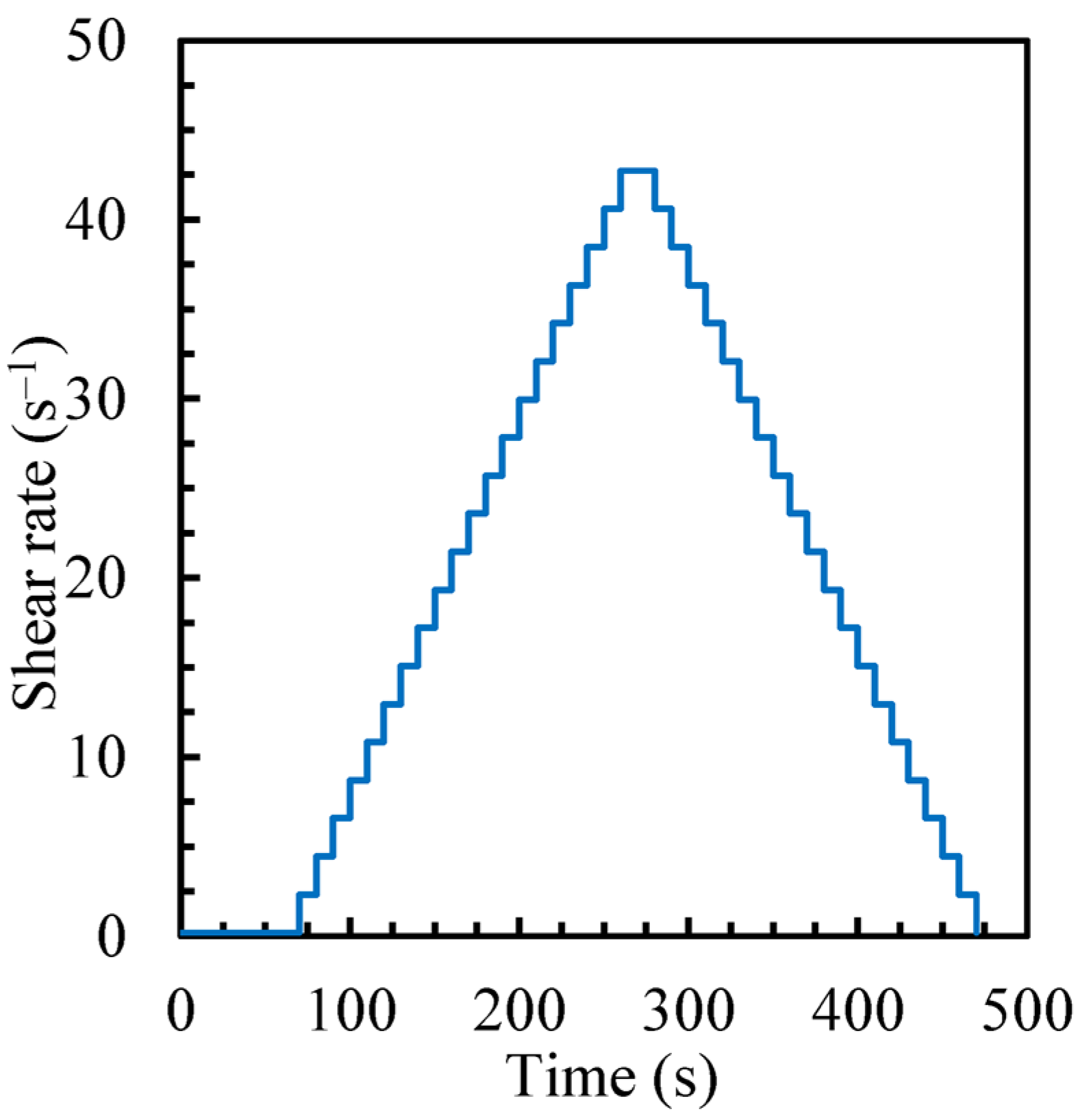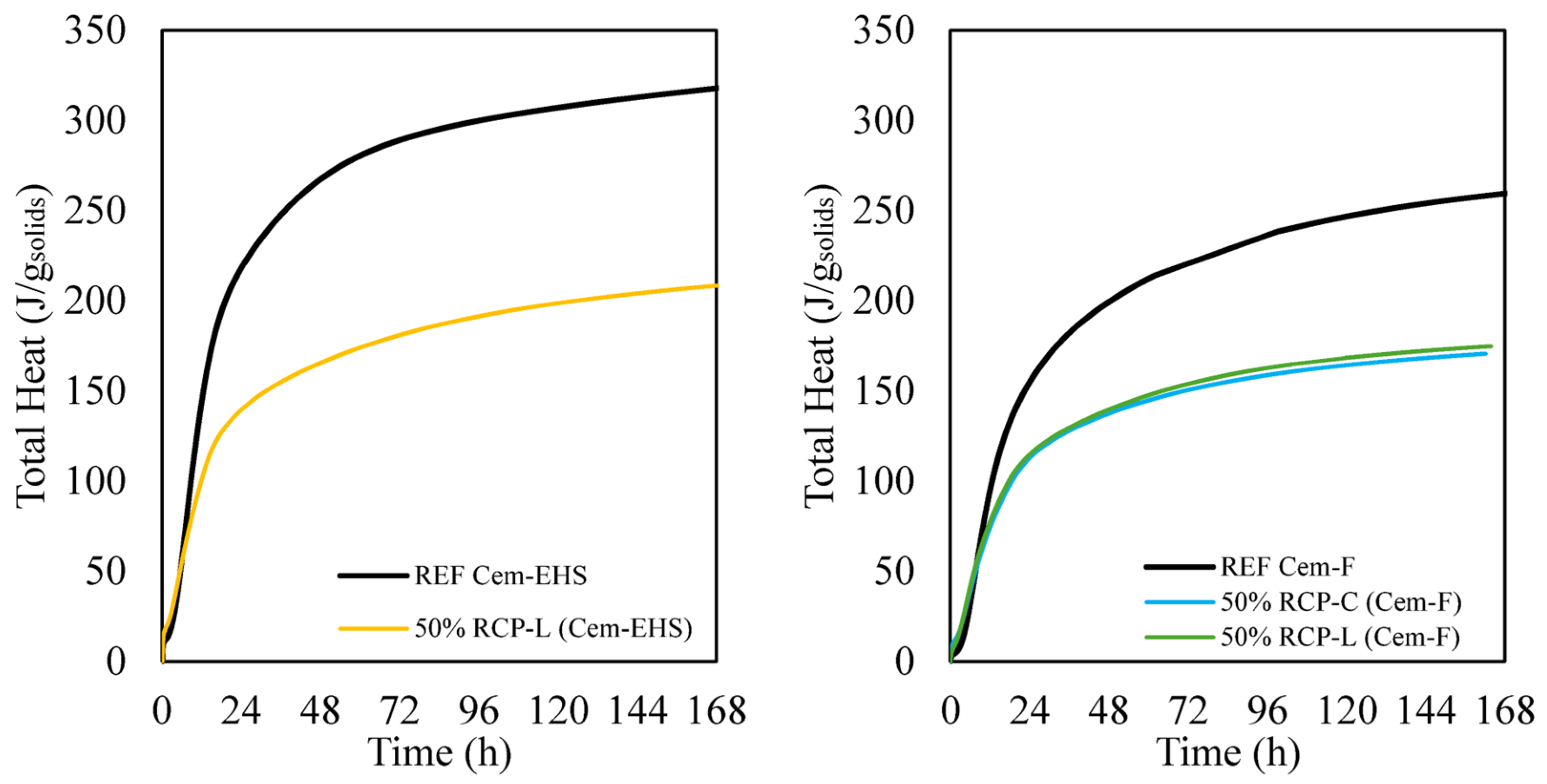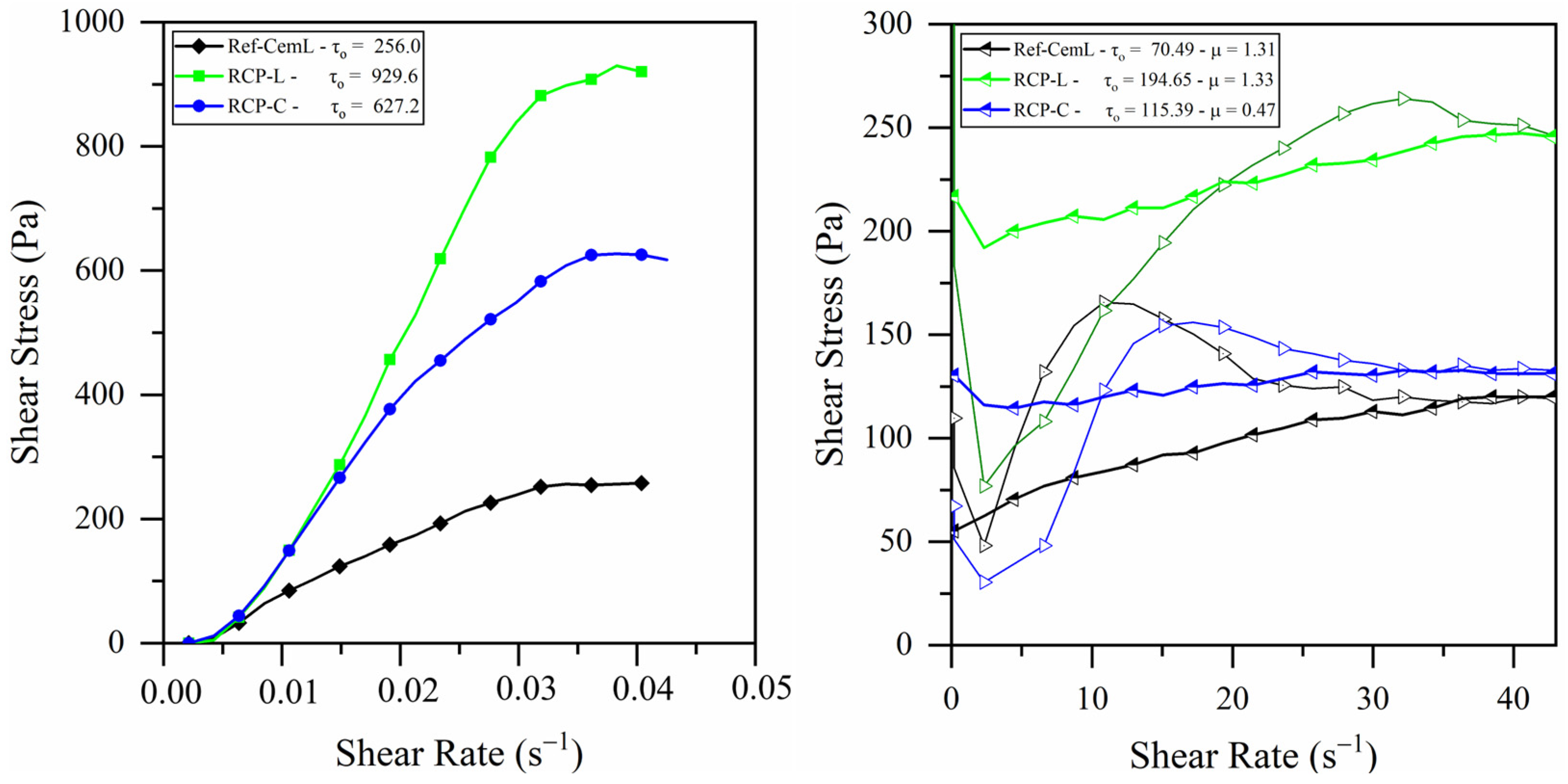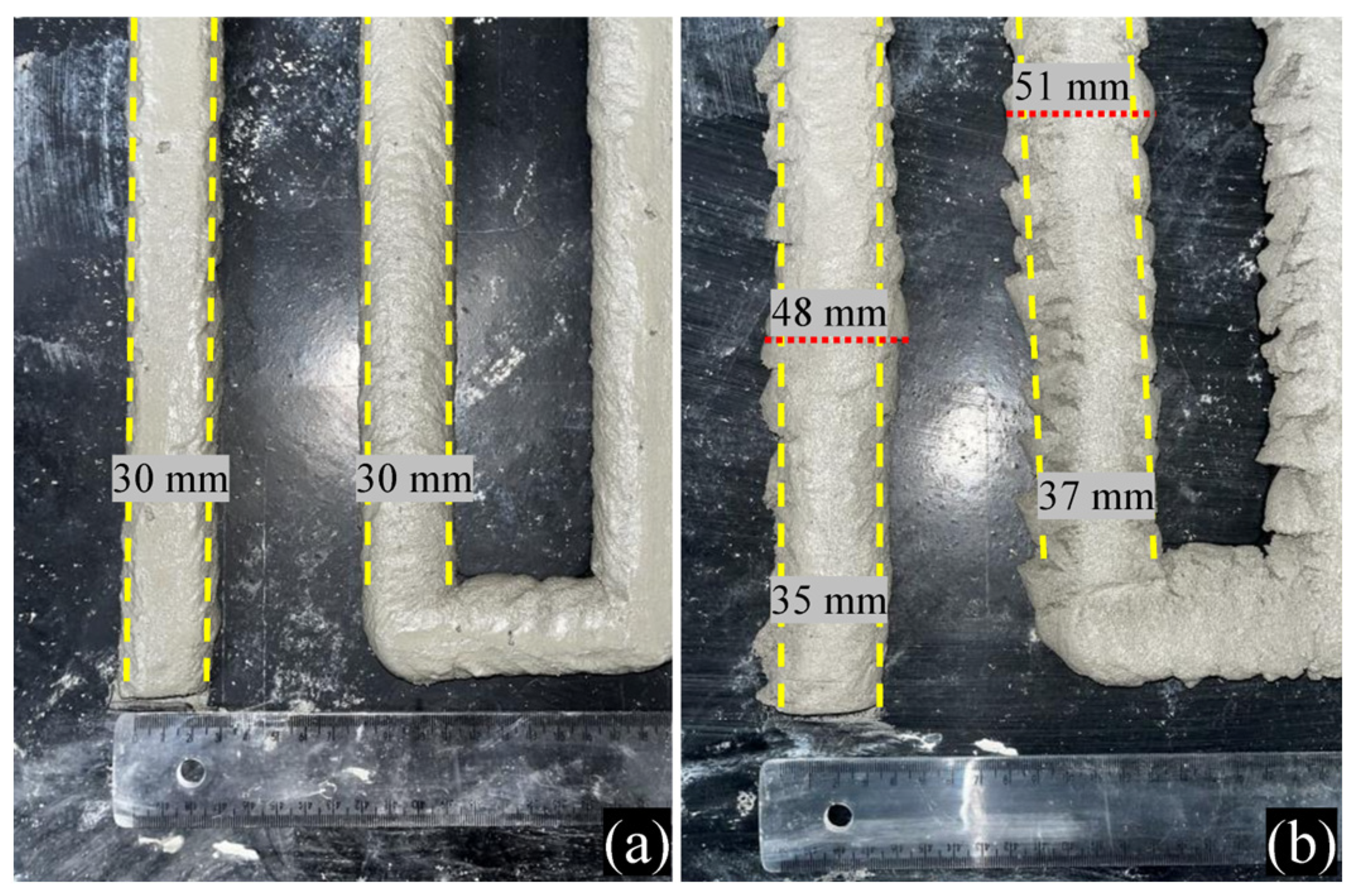Rheological and Environmental Implications of Recycled Concrete Powder as Filler in Concrete 3D Printing
Abstract
1. Introduction
2. Materials and Methods
2.1. Materials
2.2. Testing in Cementitious Pastes
2.3. Life Cycle Assessment
2.4. 3D Printing Tests: Extrudability and Buildability
3. Results
3.1. Raw Material Properties
3.2. Effect of RCPs on Cementitious Pastes
3.2.1. Effects of RCP on Packing Density
3.2.2. Effects of RCP on Hydration of Cementitious Pastes
3.2.3. Effects of RCP on Rheology
3.3. Life Cycle Assessment Results
3.4. Printing Tests
4. Discussion
5. Conclusions
- The use of both recycled powders affected the hydration of cement pastes by increasing heat release at the induction period and shifting the acceleration phase to earlier hours due to a filler effect. However, the two powders did not contribute fully to the hydration as a much lower heat emitted at 7 days by pastes with RCP is observed.
- The effects caused by rheological behavior in cement pastes were dependent on the origin of the recycled powder, with RCP-L of controlled origin presenting gains in yield stress and plastic viscosity, whereas RCP-C also increased yield stress but at a lower proportion than RCP-L, and the lowest viscosity on cementitious pastes.
- The low water absorption measured for the RCPs did not seem to influence the rheological behavior of the pastes. The specific surface area, on the other hand, supports the fact that RCP-L mixtures faced more active hydration in the first hours.
- While viscosity is greatly influenced if packing density increases, the lower packing due to the 50% fraction of powder implies that their viscosity values are at their maximum. Higher packing also justifies lower plastic viscosity, but as RCP-C still causes increases in yield stress, this powder can still provide good buildability while imposing less risk of pumpability than RCP-L.
- The environmental impacts of printable mixtures are significantly reduced by lowering cement content with recycled concrete powders (RCPs), achieving up to 62% reduction in CO2 emissions, and extra reduction can also be achieved using Portland cement with less clinker content such as the limestone filler cement used in this work.
- Distinct effects are expected when using recycled powders from different concrete sources. The effects of each material in hydration and their composition, therefore, must be considered when designing new 3D printable mixtures with RCPs, but suitable rheological properties can still be achieved or even enhanced by the presence of these powders at 50% replacement of cement.
- The extrudability and buildability tests highlighted the complexity of using high RCP content in printable mixtures, as more careful adjustments are needed to tailor the extrusion-induced changes in rheological behavior after pumping. The technical and environmental feasibility of these novel mixtures is closely dependent on the balance of adequate pumpability and conditions of each printing system.
Supplementary Materials
Author Contributions
Funding
Data Availability Statement
Acknowledgments
Conflicts of Interest
References
- Wangler, T.; Roussel, N.; Bos, F.P.; Salet, T.A.M.; Flatt, R.J. Digital Concrete: A Review. Cem. Concr. Res. 2019, 123, 105780. [Google Scholar] [CrossRef]
- Zhang, J.; Wang, J.; Dong, S.; Yu, X.; Han, B. A review of the current progress and application of 3D printed concrete. Compos. Part A Appl. Sci. Manuf. 2019, 125, 105533. [Google Scholar] [CrossRef]
- García de Soto, B.; Agustí-Juan, I.; Hunhevicz, J.; Joss, S.; Graser, K.; Habert, G.; Adey, B.T. Productivity of digital fabrication in construction: Cost and time analysis of a robotically built wall. Autom. Constr. 2018, 92, 297–311. [Google Scholar] [CrossRef]
- Perrot, A. 3D Printing of Concrete: State of the Art and Challenges of the Digital Construction Revolution; Wiley-ISTE: Hoboken, NJ, USA, 2019; pp. 1–148. [Google Scholar]
- Roussel, N.; Ovarlez, G.; Garrault, S.; Brumaud, C. The origins of thixotropy of fresh cement pastes. Cem. Concr. Res. 2012, 42, 148–157. [Google Scholar] [CrossRef]
- Roussel, N. Rheological requirements for printable concretes. Cem. Concr. Res. 2018, 112, 76–85. [Google Scholar] [CrossRef]
- Banfill, P.F.G. Rheology of Fresh Cement and Concrete; CRC Press: Boca Raton, FL, USA, 2006; pp. 61–130. [Google Scholar]
- Tinoco, M.P.; de Mendonça, É.M.; Fernandez, L.I.C.; Caldas, L.R.; Reales, O.A.M.; Filho, R.D.T. Life cycle assessment (LCA) and environmental sustainability of cementitious materials for 3D concrete printing: A systematic literature review. J. Build. Eng. 2022, 52, 104456. [Google Scholar] [CrossRef]
- Fernandez, L.I.C.; Caldas, L.R.; Mendoza Reales, O.A. Environmental evaluation of 3D printed concrete walls considering the life cycle perspective in the context of social housing. J. Build. Eng. 2023, 74, 106915. [Google Scholar] [CrossRef]
- Motalebi, A.; Khondoker, M.A.H.; Kabir, G. A systematic review of life cycle assessments of 3D concrete printing. Sustain. Oper. Comput. 2024, 5, 41–50. [Google Scholar] [CrossRef]
- Zhang, H.; Liu, X.; Xiao, J.; Ji, G.; Zhang, S.; Hsu, S.-C.; Poon, C.-S. Comparative eco-efficiency assessment of 3D-printed recycled aggregate concrete structure for mid-rise residential buildings. J. Build. Eng. 2024, 95, 110349. [Google Scholar] [CrossRef]
- Huang, B.; Ge, Y.; Wang, X.; Wang, Y.; Wang, J.; Song, C.; Zhu, J.; Amaechi, C.V.; Sun, J. Recycled ceramic brick powder utilization in fiber reinforced 3D printing concrete: An eco-friendly substitute to conventional fine aggregates. J. Build. Eng. 2024, 98, 111441. [Google Scholar] [CrossRef]
- Andrew, R.M. Global CO2 emissions from cement production, 1928–2018. Earth Syst. Sci. Data 2019, 11, 1675–1710. [Google Scholar] [CrossRef]
- IEA. WBCSD Technology Roadmap—Low-Carbon Transition in the Cement Industry; IEA: Paris, France; CSI/WBCD: Geneva, Switzerland, 2018; Available online: https://iea.blob.core.windows.net/assets/cbaa3da1-fd61-4c2a-8719-31538f59b54f/TechnologyRoadmapLowCarbonTransitionintheCementIndustry.pdf (accessed on 1 April 2025).
- Bhattacherjee, S.; Basavaraj, A.S.; Rahul, A.; Santhanam, M.; Gettu, R.; Panda, B.; Schlangen, E.; Chen, Y.; Copuroglu, O.; Ma, G.; et al. Sustainable materials for 3D concrete printing. Cem. Concr. Compos. 2021, 122, 104156. [Google Scholar] [CrossRef]
- Zheng, L.; Wu, H.; Zhang, H.; Duan, H.; Wang, J.; Jiang, W.; Dong, B.; Liu, G.; Zuo, J.; Song, Q. Characterizing the generation and flows of construction and demolition waste in China. Constr. Build. Mater. 2017, 136, 405–413. [Google Scholar] [CrossRef]
- Gálvez-Martos, J.L.; Styles, D.; Schoenberger, H.; Zeschmar-Lahl, B. Construction and demolition waste best management practice in Europe. Resour. Conserv. Recycl. 2018, 136, 166–178. [Google Scholar] [CrossRef]
- Verian, K.P.; Ashraf, W.; Cao, Y. Properties of recycled concrete aggregate and their influence in new concrete production. Resour. Conserv. Recycl. 2018, 133, 30–49. [Google Scholar] [CrossRef]
- Qian, H.; Hua, S.; Yue, H.; Feng, G.; Qian, L.; Jiang, W.; Zhang, L. Utilization of recycled construction powder in 3D concrete printable materials through particle packing optimization. J. Build. Eng. 2022, 61, 105236. [Google Scholar] [CrossRef]
- Xiao, J.; Ma, Z.; Sui, T.; Akbarnezhad, A.; Duan, Z. Mechanical properties of concrete mixed with recycled powder produced from construction and demolition waste. J. Clean. Prod. 2018, 188, 720–731. [Google Scholar] [CrossRef]
- Rocha, J.H.A.; Toledo Filho, R.D. The utilization of recycled concrete powder as supplementary cementitious material in cement-based materials: A systematic literature review. J. Build. Eng. 2023, 76, 107319. [Google Scholar] [CrossRef]
- Ruth Bola Oliveira, D.; Leite, G.; Possan, E.; Marques Filho, J. Concrete powder waste as a substitution for Portland cement for environment-friendly cement production. Constr. Build. Mater. 2023, 397, 132382. [Google Scholar] [CrossRef]
- Kim, J.; Nciri, N.; Sicakova, A.; Kim, N. Characteristics of waste concrete powders from multi-recycled coarse aggregate concrete and their effects as cement replacements. Constr. Build. Mater. 2023, 398, 132525. [Google Scholar] [CrossRef]
- Zhang, H.; Zhang, C.; He, B.; Yi, S.; Tang, L. Recycling fine powder collected from construction and demolition wastes as partial alternatives to cement: A comprehensive analysis on effects, mechanism, cost and CO2 emission. J. Build. Eng. 2023, 71, 106507. [Google Scholar] [CrossRef]
- Ding, T.; Xiao, J.; Zou, S.; Wang, Y. Hardened properties of layered 3D printed concrete with recycled sand. Cem. Concr. Compos. 2020, 113, 103724. [Google Scholar] [CrossRef]
- Xiao, J.; Zou, S.; Yu, Y.; Wang, Y.; Ding, T.; Zhu, Y.; Yu, J.; Li, S.; Duan, Z.; Wu, Y.; et al. 3D recycled mortar printing: System development, process design, material properties and on-site printing. J. Build. Eng. 2020, 32, 101779. [Google Scholar] [CrossRef]
- Wu, Y.; Liu, C.; Liu, H.; Zhang, Z.; He, C.; Liu, S.; Zhang, R.; Wang, Y.; Bai, G. Study on the rheology and buildability of 3D printed concrete with recycled coarse aggregates. J. Build. Eng. 2021, 42, 103030. [Google Scholar] [CrossRef]
- Rahul, A.V.; Mohan, M.K.; De Schutter, G.; Van Tittelboom, K. 3D printable concrete with natural and recycled coarse aggregates: Rheological, mechanical and shrinkage behaviour. Cem. Concr. Compos. 2022, 125, 104311. [Google Scholar] [CrossRef]
- Duan, Z.; Hou, S.; Xiao, J.; Singh, A. Rheological properties of mortar containing recycled powders from construction and demolition wastes. Constr. Build. Mater. 2020, 237, 117622. [Google Scholar] [CrossRef]
- Hou, S.; Xiao, J.; Duan, Z.; Ma, G. Fresh properties of 3D printed mortar with recycled powder. Constr. Build. Mater. 2021, 309, 125186. [Google Scholar] [CrossRef]
- Zhang, H.; Xiao, J.; Duan, Z.; Zou, S.; Xia, B. Effects of printing paths and recycled fines on drying shrinkage of 3D printed mortar. Constr. Build. Mater. 2022, 342, 128007. [Google Scholar] [CrossRef]
- De Vlieger, J.; Boehme, L.; Blaakmeer, J.; Li, J. Buildability assessment of mortar with fine recycled aggregates for 3D printing. Constr. Build. Mater. 2023, 367, 130313. [Google Scholar] [CrossRef]
- Pepe, M.; Lombardi, R.; Lima, C.; Paolillo, B.; Martinelli, E. Experimental Evidence on the Possible Use of Fine Concrete and Brick Recycled Aggregates for 3D Printed Cement-Based Mixtures. Materials 2025, 18, 583. [Google Scholar] [CrossRef]
- Cavalcante, T.C.; Toledo Filho, R.D.; Mendoza Reales, O.A. Influence of Recycled Concrete Powder on Rheology of Printable Cement-Based Matrixes. ACI Mater. J. 2024, 121, 69–80. [Google Scholar] [CrossRef]
- ASTM C150-07; Standard Specification for Portland Cement. ASTM: West Conshohocken, PA, USA, 2007.
- ASTM C595/C595M-24; Standard Specification for Blended Hydraulic Cements. ASTM: West Conshohocken, PA, USA, 2024.
- Rangel, C.S.; Toledo Filho, R.D.; Amario, M.; Pepe, M.; de Castro Polisseni, G.; de Andrade, G.P. Generalized quality control parameter for heterogenous recycled concrete aggregates: A pilot scale case study. J. Clean. Prod. 2019, 208, 589–601. [Google Scholar] [CrossRef]
- Castro, J.; Keiser, L.; Golias, M.; Weiss, J. Absorption and desorption properties of fine lightweight aggregate for application to internally cured concrete mixtures. Cem. Concr. Compos. 2011, 33, 1001–1008. [Google Scholar] [CrossRef]
- De Larrard, F. Concrete Mixture Proportioning: A Scientific Approach; CRC Press: Boca Raton, FL, USA, 2011. [Google Scholar]
- ISO 14040:2006; Environmental Management—Life Cycle Assessment—Principles and Framework. International Organization for Standardization: Geneva, Switzerland, 2006.
- ISO 14044:2006; Environmental Management—Life Cycle Assessment—Requirements and Guidelines. International Organization for Standardization: Geneva, Switzerland, 2006.
- Borghi, G.; Pantini, S.; Rigamonti, L. Life cycle assessment of non-hazardous Construction and Demolition Waste (CDW) management in Lombardy Region (Italy). J. Clean. Prod. 2018, 184, 815–825. [Google Scholar] [CrossRef]
- Berodier, E.; Scrivener, K. Understanding the Filler Effect on the Nucleation and Growth of C-S-H. J. Am. Ceram. Soc. 2014, 97, 3764–3773. [Google Scholar] [CrossRef]
- Bianchi, I.; Volpe, S.; Fiorito, F.; Forcellese, A.; Sangiorgio, V. Life cycle assessment of building envelopes manufactured through different 3D printing technologies. J. Clean. Prod. 2024, 440, 140905. [Google Scholar] [CrossRef]
- Cavalcante, T.C.; Castrillon Fernandez, L.I.; Toledo Filho, R.D.; Mendoza Reales, O.A. 3D printable mortars with different recycled concrete powders as fillers. In Proceedings of the 4th RILEM International Conference on Concrete and Digital Fabrication (Digital Concrete 2024), Munich, Germany, 4–6 September 2024. [Google Scholar] [CrossRef]
















| Mixture | Cement | RCP | Water (Bwos 1) |
|---|---|---|---|
| P-CemHES | 1.00 | 0.00 | 0.42 |
| P-CemHES-RCP-L | 0.50 | 0.50 | 0.42 |
| P-CemL | 1.00 | 0.00 | 0.42 |
| P-CemL-RCP-L | 0.50 | 0.50 | 0.42 |
| P-CemL-RCP-C | 0.50 | 0.50 | 0.42 |
| Particle | D10 (µm) | D50 (µm) | D90 (µm) | Specific Mass (g/cm3) | Blaine Surface Area (cm2/g) | B.E.T Surface Area (m2/g) |
|---|---|---|---|---|---|---|
| CemHES | 2.6 | 14.4 | 39.0 | 3111 | 3953 | - |
| CemL | 2.0 | 11.6 | 32.9 | 3074 | 3854 | - |
| RCP-L | 5.7 | 50.7 | 152.6 | 2609 | 5079 | 4614 |
| RCP-C | 7.3 | 70.1 | 191.9 | 2605 | 3531 | 3601 |
| Oxide | CemHES | CemL | RCP-C | RCP-L |
|---|---|---|---|---|
| (%) | ||||
| CaO | 67.55 | 65.91 | 30.53 | 36.94 |
| SiO2 | 12.83 | 11.50 | 29.25 | 24.10 |
| Al2O3 | 3.05 | 3.34 | 11.66 | 8.95 |
| Fe2O3 | 4.32 | 4.43 | 5.01 | 6.44 |
| SO3 | 3.64 | 3.41 | 2.31 | 2.16 |
| K2O | 0.49 | 0.38 | 2.56 | 1.75 |
| TiO2 | 0.28 | 0.25 | 0.76 | 0.98 |
| MnO | 0.09 | 0.06 | 0.31 | 0.44 |
| SrO | - | 0.32 | 0.17 | 0.17 |
| ZrO2 | 0.04 | - | 0.08 | 0.31 |
| ZnO | 0.02 | 0.04 | - | 0.03 |
| Rb2O | - | - | 0.02 | 0.02 |
| Y2O3 | - | - | 0.01 | - |
| CuO | - | 0.03 | - | - |
| LOI | 7.09 | 10.34 | 17.32 | 17.70 |
| Material | β | Mixture | γ |
|---|---|---|---|
| CemHES | 0.540 | P-Ref-HES | 0.540 |
| CemL | 0.551 | P-Ref-L | 0.551 |
| RCP-C | 0.437 | P-CemL-C | 0.617 |
| RCP-L | 0.466 | P-CemL-L | 0.589 |
| Mixture | CemHES | CemL | RCP-L | RCP-C | Total |
|---|---|---|---|---|---|
| P-CemHES | 1114.4 | 0.0 | 0.0 | 0.0 | 1114.4 |
| P-CemHES-RCP-L | 534.9 | 0.0 | 7.4 | 0.0 | 542.3 |
| P-CemL | 0.0 | 860.0 | 0.0 | 0.0 | 860.0 |
| P-CemL-RCP-L | 0.0 | 413.9 | 7.4 | 0.0 | 421.3 |
| P-CemL-RCP-C | 0.0 | 413.8 | 0.0 | 7.4 | 421.1 |
Disclaimer/Publisher’s Note: The statements, opinions and data contained in all publications are solely those of the individual author(s) and contributor(s) and not of MDPI and/or the editor(s). MDPI and/or the editor(s) disclaim responsibility for any injury to people or property resulting from any ideas, methods, instructions or products referred to in the content. |
© 2025 by the authors. Licensee MDPI, Basel, Switzerland. This article is an open access article distributed under the terms and conditions of the Creative Commons Attribution (CC BY) license (https://creativecommons.org/licenses/by/4.0/).
Share and Cite
Cavalcante, T.C.; Filho, R.D.T.; Reales, O.A.M. Rheological and Environmental Implications of Recycled Concrete Powder as Filler in Concrete 3D Printing. Buildings 2025, 15, 1280. https://doi.org/10.3390/buildings15081280
Cavalcante TC, Filho RDT, Reales OAM. Rheological and Environmental Implications of Recycled Concrete Powder as Filler in Concrete 3D Printing. Buildings. 2025; 15(8):1280. https://doi.org/10.3390/buildings15081280
Chicago/Turabian StyleCavalcante, Tiago Canavarro, Romildo Dias Toledo Filho, and Oscar Aurelio Mendoza Reales. 2025. "Rheological and Environmental Implications of Recycled Concrete Powder as Filler in Concrete 3D Printing" Buildings 15, no. 8: 1280. https://doi.org/10.3390/buildings15081280
APA StyleCavalcante, T. C., Filho, R. D. T., & Reales, O. A. M. (2025). Rheological and Environmental Implications of Recycled Concrete Powder as Filler in Concrete 3D Printing. Buildings, 15(8), 1280. https://doi.org/10.3390/buildings15081280








